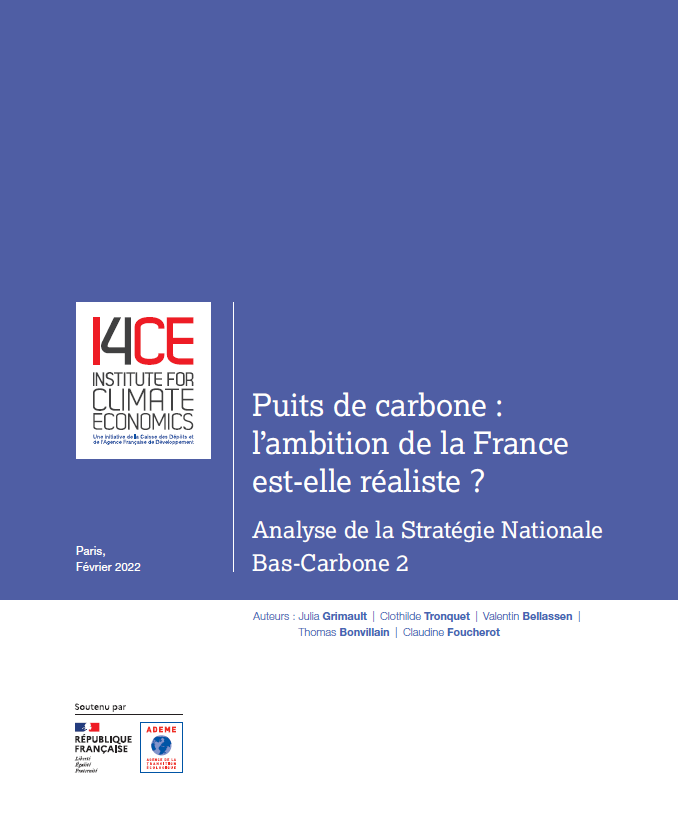Carbon sinks: is France’s ambition realistic?
Analysis of the second National Low-Carbon Strategy
The French National Low-Carbon Strategy (SNBC) aims at doubling the volume of CO2 removals thanks to the contribution of the forest-based sector, the agricultural sector and the geological carbon capture and storage technologies. The projections concerning these compartments and the underlying technical assumptions have been explored and compared to the existing literature in an in-depth analysis, with the goal of clarifying the challenges and conditions for this massive increase in carbon removals. The conclusions are that far-reaching changes are required in the different sectors and that some objectives for the forest-based sector may be impossible to achieve.
The report will be available in English in December
1. Key trends: new contributing sectors and a profound transformation of the forest and wood sink
It is common knowledge that the National Low-Carbon Strategy (SNBC) plans to double the carbon sink between 2015 and 2050. But what about the composition of this sink? How is it expected to evolve? Our in-depth analysis of the SNBC shows that it radically changes the composition of the French carbon sink (Figure 1): forest sequestration (1995 scope), which represents 115% of the net balance in 2015, loses 70% of its value, whereas storage in wood products and in geological formations, which are almost non-existent in 2015, gain considerable importance.
Click here to see “Figure 1: The carbon sink in the National Low-Carbon Strategy”
These changes arise from the action of 10 major levers (Figure 2). In the forest-wood sector, the SNBC relies on an increase in harvesting, even if this means reducing the national sink by 32 MtCO2/year in existing forests, with half of this reduction offset by redirecting the wood harvested towards long-lived uses. New planting on grasslands are considered to be marginal, the extension of afforestation through natural colonisation and the reduction of deforestation also enable storage of 17 MtCO2/year, resulting in near stability of the sink for the sector as a whole at around 50 MtCO2/year.
The net increase in the sink of around 40 MtCO2/year is therefore primarily due to geological carbon capture and storage (CCS) (+15 MtCO2/year), hedgerow planting (+7 MtCO2/year), maintenance of grasslands (+7 MtCO2/year) and artificialisation (+5 MtCO2/year). Note that several levers have not been attributed, due to interaction between levers and the lack of documentation on some points in the official document and the annexes provided by the ministries and CITEPA.
Click here to see “Figure 2: Storage levers in the National Low-Carbon Strategy”
2. Ambitious in all fronts, the Strategy probably pushes the boundaries of realism for wood product
To assess the degree of realism of the National Low-Carbon Strategy for the land sector, we compare it to baseline studies in terms of carbon storage potential at the national level. These comparisons show that the National Low-Carbon Strategy is ambitious in most aspects, which is not surprising: the overall objective of the Strategy, in other words carbon neutrality in France, is itself ambitious and calls for major changes in all sectors.
However, concerning the massive redirection of wood towards long-lived uses, the Strategy probably pushes the boundaries of realism:
- From a technical point of view: the share of sawn wood in the total harvest increases from 10% to 20%, whereas this share, largely linked to the quality of existing wood, seems difficult to substantially modify by 2050. Moreover, since sawn wood is a high value-added market, it can be assumed to be already close to its maximum potential.
- From a market point of view: the increase in the production of panels provided for in the SNBC (+244% between 2015 and 2050) cannot be absorbed by domestic demand and will therefore need to rely on massive exports. Even the most optimistic demand scenario in the construction sector only increases panel consumption by 80%. Other sectors could absorb some of the surplus, such as furniture, but this is still a long way from the increases required. However, including wood-based insulation in this category, and especially wood wool, could also help to expand opportunities.
- This focus on reducing the carbon sink in ecosystems in favour of storage in wood products depends on the success of the massive redirection of wood uses towards long-lived products. The practicality of this redirection is therefore all the more crucial: if harvesting is successfully increased without any massive redirection of uses, then this increase will be significantly more detrimental to the value of the sink in 2050 and the impact of the strategy on the forest-wood sink will be negative.
The other main levers also face significant obstacles, but are closer to the assumptions made in the recent literature:
- The increase in wood harvesting is technically feasible, even if it requires far-reaching changes in the productive system: without major changes in the structure of the sector and massive investments in processing plants, the level of harvesting in the SNBC cannot be achieved, even with very high subsidies.
- Geological carbon capture and storage of 15 MtCO2/year is technically compatible with existing assessments, for a cost of less than 100 €/tCO2 on average. But once again, this storage requires massive development (the current global level stands at barely 23 MtCO2/year). Moreover, bioenergy with carbon capture and storage (BECCS) accounts for two thirds of the total and its implementation may require biomass plants that are around eight times bigger than the current average size for fuelwood. This massification carries risks in terms of supply and social and environmental acceptability, questioning the relevance of these technologies.
- Maintenance of grasslands and zero agricultural land-take are technically feasible, but require more effective policies: preserving grasslands has in fact been an objective of agricultural policies for the last 30 years, without any real impact on the number of net conversions, and zero land-take, despite being a more recent policy objective, has been no more successful.
- Increasing agroforestry areas and hedgerows by a factor of five also implies stepping up public policies, but the storage potential is consistent with the maximum technical levels assessed by INRAE.
- The planting of 15-20 kha/year of forests as a substitute for natural colonisation areas in grasslands, combined with natural forest expansion of comparable magnitude, is consistent with the historical regeneration areas of 50 kha/year over the last 30 years, and compatible with the reduction in livestock provided for in the SNBC.
Finally, for two major levers of soil carbon storage, namely scaling up intermediate crops and replacing forage maize with temporary grasslands, the SNBC projects storage levels that are respectively two to ten times lower than the potential evaluated by INRAE for a cost of 250 €/tCO2eq. These levers are therefore technically realistic, but will require major and rapid practice changes.
3. Recommandations
Sectoral recommendations
1. The forestry levers seem the most difficult to implement in view of the existing literature. However, the redirection of wood uses is an important “no regrets” strategy that is insufficiently addressed in the academic literature. Consequently, we recommend:
- Prioritising the redirection of wood uses rather than an increase in harvesting in public policies.
- More accurately characterising pathways for wood products (types of products to develop, processing sectors, outlets) to achieve 50% of the harvest allocated to long-lived products in 2050.
- Reducing the global ambition on the sink in products, according to actual and desirable harvesting possibilities, and to the development of long-lived wood uses consistent with the possible outlets.
The goal of these recommendations is to ensure that the strategy concerning a large ex situ forest sink is actually achieved, in order to avoid a negative overall carbon impact due to a high level of harvesting that is not redirected towards long-lived products.
2. The agricultural storage levers envisaged in the SNBC and the associated orders of magnitude are credible in view of the technical and economic potentials identified in the literature. However, reversing the historical trend towards destocking in agricultural ecosystems requires huge efforts, especially in economic terms for grasslands maintenance and agroforestry development.
3. Finally, even if the development of CCS technologies proposed in the SNBC is consistent with the simulations projected in the literature, there are still considerable technical and economic challenges facing the massification of these technologies. Moreover, the requirements in terms of large-scale installations and massive supplies of biomass energy for BECCS can be difficult to reconcile with sustainability obligations.
Recommendations concerning the drafting and operationalisation of the SNBC3
Finally, to enable all stakeholders to take full ownership of the issues concerning them, we recommend:
- Making the assumptions and underlying scenarios accessible to stakeholders in a transparent manner to facilitate their uptake. We note that the forest part of this detailed analysis has been greatly facilitated by the provision of the spreadsheet developed by the French Ministry of Ecological Transition. To make it easier for all stakeholders to take ownership of the SNBC core document, we recommend that for the next editions, spreadsheets of this type should be made publicly available for all the components of the SNBC.
- Developing more specific scenarios by sector during the SNBC drafting stage, in other words going beyond biophysical scenarios in order to clarify the changes implied in the different economic sectors. This recommendation is particularly important for the redirection of wood uses.


